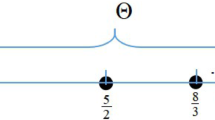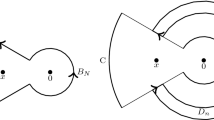Abstract
In this short note, we give an easy proof of the following result: for \( n\ge 2, \) \(\underset{t\rightarrow 0}{\lim }\ \,e^{it\Delta }f\left( x+\gamma (t)\right) = f(x) \) almost everywhere whenever \( \gamma \) is an \( \alpha \)-Hölder curve with \( \frac{1}{2}\le \alpha \le 1 \) and \( f\in H^s({\mathbb {R}}^n) \), with \( s > \frac{n}{2(n+1)} \). This is the optimal range of regularity up to the endpoint.
Similar content being viewed by others
Avoid common mistakes on your manuscript.
1 Introduction
Consider the linear Schrödinger equation on \( {\mathbb {R}}^n\times {\mathbb {R}}\), \( n\ge 1, \) given by
Its solution can be formally expressed as
It was first proposed by Carleson in 1980 [3] to find the values of \( s>0 \) for which
holds true for all functions \( f\in H^s({\mathbb {R}}^n) \). Carleson [3] proved this convergence when \( n=1 \) and \( s\ge \frac{1}{4}\). Later, in 2006, Dahlberg and Kenig [6] showed that (3) was false whenever \( s<\frac{1}{4}. \)
Many researchers have worked in this problem throughout the years. Authors such as Carbery, Cowling, Vega, Sjölin, Moyua, Vargas, Tao, Lee and Bourgain to name a few. More recently, the problem has been solved in higher dimensions, except for the endpoint. In 2016, Bourgain [1] proved the necessity of \( s\ge \frac{n}{2(n+1)} \) in order to have (3). In 2017, Du et al. [7] proved the sufficiency of the condition \( s>\frac{1}{3} \) when \( n=2. \) Later, in 2019, Du and Zhang [8] proved the sufficiency of \( s>\frac{n}{2(n+1)} \) for general \( n\ge 3. \) A more detailed history of the problem can be found in [8] and the references therein.
Take a solution of (1). Consider a set of curves \( \rho (x,t) = x + \gamma (t) \) that are bi-Lipschitz in \( x\in {\mathbb {R}}^n \) and \( \alpha \)-Hölder in \( t\in {\mathbb {R}}\). Cho et al. [4] proved in 2012 that \( u\left( \rho (x,t),t\right) \) converges to f(x) almost everywhere as \( t\rightarrow 0 \) in \( n=1 \) when \( s>\max \left\{ \frac{1}{2}-\alpha , \frac{1}{4} \right\} \). They also found this to be sharp up to the endpoint. Later, in 2021, Li and Wang [11] proved that convergence in dimension \( n = 2 \), for index \( \frac{1}{2}\le \alpha \le 1 \) and the range \( s > \frac{3}{8} \). In 2023, Cao and Miao [2] gave a proof for general dimension n, index \( \frac{1}{2}\le \alpha \le 1 \), and \( s>\frac{n}{2(n+1)} \). Their proof followed the argument presented in [8] and relied on techniques such as dyadic pigeonholing, broad-narrow analysis and induction on scales.
Our objective is to give an easy proof of the result in [2] without using the aforementioned techniques.
Fix \(0<\alpha \le 1\) and \(\tau \ge 1.\) We consider the family of curves,
The convergence result follows from the maximal bound below. Let \( B_r^n(x_0) \) denote the ball of radius \( r>0 \) centered at \( x_0\in {\mathbb {R}}^n \).
Theorem 1.1
Let \(n \ge 1\). Fix \( \frac{1}{2}\le \alpha \le 1 \) and \(\tau \ge 1 \). For any \(\varepsilon >0\), there exists a positive constant \(C_{\varepsilon ,\tau }\) such that, for every \( \gamma \in \Gamma _{\tau }^\alpha \),
holds for all f \( \in H^{\frac{n}{2(n+1)}+\epsilon }({\mathbb {R}}^n). \)
Remark 1.2
A change of variables shows that it is enough to consider the case \( \tau = 1 \). From now on we assume \( \tau = 1.\)
Then, we can reduce Theorem 1.1 as in [8]. We begin with a definition.
Definition 1.3
Fixed \(0<\alpha \le 1\) and \( R>1 \), we define
By Littlewood–Paley decomposition, the time localization lemma (e.g. Lemma 3.1 in Lee [9]) and parabolic rescaling, Theorem 1.1 can be reduced to the following Theorem 1.4.
Theorem 1.4
Let \(n \ge 1\) and \( \frac{1}{2}\le \alpha <1 \). For any \(\varepsilon >0\), there exists a constant \(C_{\varepsilon }\) such that, for all \( \gamma \in \Gamma ^{\alpha }\left( R^{-1}\right) \),
holds for all \(R \ge 1\) and all f with \({\text {supp}} \widehat{f} \subset A(1)=\left\{ \xi \in \mathbb {R}^n:|\xi | \sim 1\right\} \).
2 Intermediate Results
We consider the following result from [8].
Theorem 2.1
(Corollary 1.7 in [8]) Let \(n \ge 1\). For any \(\varepsilon >0\), there exists a constant \(C_{\varepsilon }\) such that the following holds for all \(R \ge 1\) and all f with \({\text {supp}} \widehat{f} \subset B_1^n(0)\). Suppose that \(X=\cup _k B_k\) is a union of lattice unit cubes in \(B_R^{n+1}(0)\). Let \(1 \le \beta \le n+1\) and
Then
We generalize the above result to include \(\alpha \)-Hölder curves.
Theorem 2.2
Let \(n \ge 1\) and \( \frac{1}{2}\le \alpha \le 1 \).
For any \(\varepsilon >0\), there exists a constant \(C_{\varepsilon }\) such that the following holds for any \(R \ge 1\), every \( \gamma \in \Gamma ^{\alpha }\left( R^{-1}\right) \) and all f with \({\text {supp}} \widehat{f} \subset B_1^n(0)\). Suppose that \(X=\cup _k B_k\) is a union of lattice unit cubes in \(B_R^{n+1}(0)\). Let \(1 \le \beta \le n+1\) and \(\phi \) be given by (8). Then
Proof of Theorem 2.2
Denote
We begin with
Denote \( (x_k,t_k)\) to be the center of \( B_k. \) Then,
Recall that \( \gamma \in \Gamma ^{\alpha }\left( R^{-1}\right) \), and \( \alpha \ge \frac{1}{2} \). Thus, if \( t\in (t_k-1,t_k+1), \) then \( \left| \theta (t)-\theta (t_k)\right| \le 1 \). Hence,
for some \( C>0. \) Note that, if \( B_4(x_k + \theta (t_k), t_k) \cap B_4(x_i + \theta (t_i), t_i) \ne \emptyset , \) then \( |t_k-t_i|\le 8. \) Since \( \alpha \ge \frac{1}{2}, \) we have \( |\theta (t_k)-\theta (t_i)| \le 8 \). Hence, \( |x_k-x_i| \le 16. \) Therefore, the balls \( \{B_4(x_k+\theta (t_k),t_k)\}_k \) have finite overlap \( C = C_n \).
Define \( Y = \bigcup _l Q_l \) to be the minimal union of lattice unit cubes satisfying that \( \bigcup _k B_4^{n+1}(x_k + \theta (t_k), t_k)\subset Y. \) We have proven that
Hence by Theorem 2.1,
We claim that
for some \( C>0. \) This would conclude the proof.
To prove (20), note that, if \( Q_l \subset B_r^{n+1}(y_0,s_0) \), \( r\ge 1, \) and \( Q_l\cap B_4^{n+1}(x_k + \theta (t_k),t_k) \ne \emptyset \), then \( B_k = B_1^{n+1}(x_k,t_k) \subset B_{r+5}^{n+1} (y_0-\theta (s_0), s_0). \)
Therefore,
\(\square \)
3 Proof of Theorem 1.4
Before the proof, let us introduce a stability property of the Schrödinger operator. More general versions of the following appeared in an article of Tao [12] from 1999 and an article of Christ [5] from 1988.
Suppose that \( {\widehat{f}} \) is supported inside a ball of radius 1.
If \( |x'-y'| \le 4 \) and \( |t'-s'|\le 4, \) then,
where \( \widehat{f_\mathfrak {l}}(\xi ) = e^{2\pi i\mathfrak {l}\xi }{\widehat{f}}(\xi )\).
Now, fix \( \alpha \ge 1/2 \) and \( \gamma \in \Gamma ^{\alpha }\left( R^{-1}\right) \). Define \( \theta \) as in (11). Whenever \( |x-y|\le 2 \) and \( |t-s|\le 2 \), we have that \( \left| x+\theta (t) - ( y + \theta (s)) \right| \le 4. \) Thus,
Therefore, if \( |x-x_0| \le 1 \) and \( |t-t_0|\le 1 \), then,
Proof of Theorem 1.4
For the sake of briefness, given \( (x,t)\in {\mathbb {R}}^{n+1} \) let us denote
Now, we can write
For each \( x_0 \), there exists \(\widetilde{t_0} = \widetilde{t_0}(x_0)\in {\mathbb {Z}}\cap [0,R] \) such that the supremum on each term of the above sum is almost attained inside \( B^{n+1}_1(x_0,\widetilde{t_0}) \). Therefore,
which is, by (24),
Therefore, denoting \( C_\mathfrak {l} = \frac{1}{(1+|\mathfrak {l}|)^{N}}\) and using Cauchy–Schwarz,
Let us choose \( X = \bigcup _{\begin{array}{c} x_0\in {\mathbb {Z}}^n \\ |x_0|<R \end{array} } B^{n+1}_2\left( x_0,\widetilde{t_0}\right) \). The above lets us deduce that
By Theorem 2.2, this is,
Recall that, given \( x_0\in {\mathbb {Z}}^n\cap B_R^n(0), \) we have chosen exactly one \( \widetilde{t_0}\in {\mathbb {Z}}\cap [0,R] \). Consequently, \( \phi _{X,n} \le 1 \). Therefore, the above inequalities yield
\(\square \)
Data Availability
Data availability is not applicable to this manuscript.
References
Bourgain, J.: A Note on the Schrödinger maximal function. J. Anal. Math. 130(1), 393–396 (2016). https://doi.org/10.1007/s11854-016-0042-8
Cao, Z., Miao, C.: Sharp pointwise convergence on the Schrödinger operator along one class of curves. Bull. Sci. Math. 184, 103254 (2023). https://doi.org/10.1016/j.bulsci.2023.103254
Carleson, L.: Some Analytic Problems Related to Statistical Mechanics. Euclidean Harmonic Analysis. Lecture Notes in Mathematics, vol. 779, pp. 5–45. Springer, Berlin (1980). https://doi.org/10.1007/BFb0087666
Cho, C., Lee, S., Vargas, A.: Problems on Pointwise Convergence of Solutions to the Schrödinger Equation. J. Fourier Anal. Appl. 18(5), 972–994 (2012). https://doi.org/10.1007/s00041-012-9229-2
Christ, M.: On the Regularity of Inverses of Singular Integral Operators. Duke Math. J. 57(2), 459–484 (1988). https://doi.org/10.1215/S0012-7094-88-05721-3
Dahlberg, B., Kenig, C.: A note on the almost everywhere behavior of solutions to the Schrödinger equation. Harmonic Anal. 908, 205–209 (2006). https://doi.org/10.1007/BFb0093289
Du, X., Guth, L., Li, X.: A sharp Schr ö dinger maximal estimate in \(\mathbb{R} ^2\). Ann. Math. 186(2), 90 (2017). https://doi.org/10.4007/annals.2017.186.2.5
Du, X., Zhang, R.: Sharp \(L^2\) estimates of the Schrödinger maximal function in higher dimensions. Ann. Math. 189(3), 837–861 (2019). https://doi.org/10.4007/annals.2019.189.3.4
Lee, S.: On pointwise convergence of the solutions to Schr ö dinger equations in \(\mathbb{R} ^2\). Int. Math. Res. Not. 2006(9), 32597 (2006). https://doi.org/10.1155/IMRN/2006/32597
Lee, S., Rogers, K.M.: The Schrödinger equation along curves and the quantum harmonic oscillator. Adv. Math. 229(3), 1359–1379 (2012). https://doi.org/10.1016/j.aim.2011.10.023
Li, W., Wang, H.: On convergence properties for generalized Schrödinger operators along tangential curves. Classical Anal. ODEs (2021). https://doi.org/10.48550/arXiv.2111.09186
Tao, T.: The Bochner–Riesz conjecture implies the restriction conjecture. Duke Math. J. 96(2), 363–375 (1999). https://doi.org/10.1215/S0012-7094-99-09610-2
Author information
Authors and Affiliations
Corresponding author
Ethics declarations
Conflict of Interest
I declare that I have no conflict of interest in relation to this manuscript.
Additional information
Publisher's Note
Springer Nature remains neutral with regard to jurisdictional claims in published maps and institutional affiliations.
Javier Minguillon was supported by Grant PID2022-142202NB-I00/AEI/10.13039/501100011033.
Rights and permissions
Springer Nature or its licensor (e.g. a society or other partner) holds exclusive rights to this article under a publishing agreement with the author(s) or other rightsholder(s); author self-archiving of the accepted manuscript version of this article is solely governed by the terms of such publishing agreement and applicable law.
About this article
Cite this article
Minguillón, J. A Note on Almost Everywhere Convergence Along Tangential Curves to the Schrödinger Equation Initial Datum. J Geom Anal 34, 333 (2024). https://doi.org/10.1007/s12220-024-01755-x
Received:
Accepted:
Published:
DOI: https://doi.org/10.1007/s12220-024-01755-x




